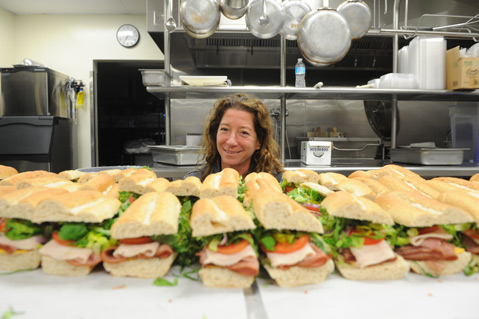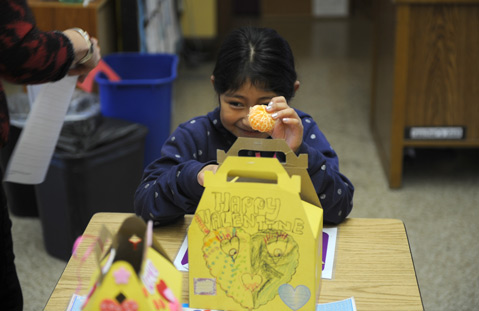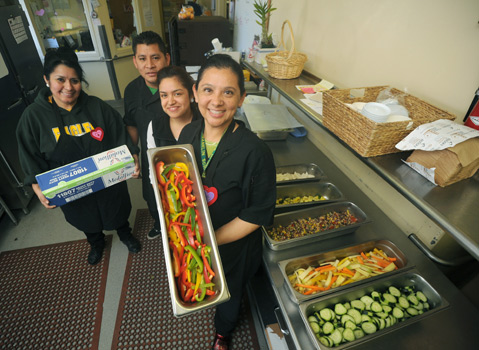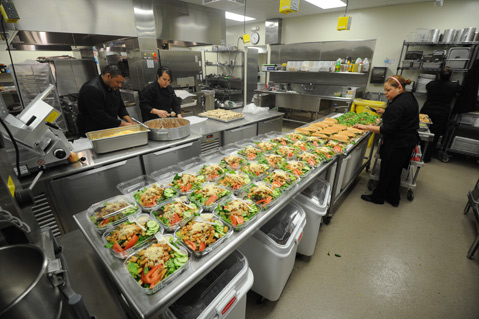Santa Barbara’s Cafeteria Queen
Nancy Weiss Heads a Reimagined School Food Program

Gone are the days when a hefty, hair-netted woman scooped slop onto kids’ Styrofoam trays and called it lunch. Nor does Taco Bell truck hundreds of beef tacos to Santa Barbara cafeterias any longer. But despite the movement to reform school lunches and completely abandon the “heat and serve” model, staff still face challenges like the stigma associated with “cafeteria food,” finicky taste buds, and food waste.
Enter Nancy Weiss, an unlikely cafeteria lady who spent 13 years in the private sector — she launched SOhO Restaurant & Music Club in 1986, among other ventures — before switching to the public one. Weiss worked for more than a decade as cafeteria manager of Goleta Valley Junior High School and is now at the helm of Santa Barbara Unified School District’s $6.1 million, 90-person food operation. Weiss frequently visits the 10 district kitchens and, when back at the office, prefers to bounce on an exercise ball rather than sit in a desk chair.
Nearly 40 percent of district students receive a free or reduced lunch. Weiss blends government subsidies — 75 percent of her budget comes from the feds — and student lunch money to feed 6,500 mouths each day. (At the high schools, a full-priced lunch is $3.25 and a reduced one is 40 cents.) “Kids spend eight hours of the day at school,” Weiss said. “It’s part of our responsibility as educators.”

Free Lunch?
In fact, Weiss wishes all students ate for free. “I can see getting crucified for that, but we’re in public education,” she said. “We need to take it one step further.” At La Cumbre Junior High School, where more than 75 percent of students are low-income, everyone eats for free, and the same is true at La Cuesta High School and a handful of the elementary schools. “Once everybody could eat for free, there was no stigma. It’s been great,” said La Cumbre’s Principal Jo Ann Caines, explaining that her staff seeks out students who aren’t eating lunch. “In a low-income home, fruit is a luxury,” she added.
Regardless of improvements in grub, students are still lured by convenience-store snacks and fast food. “My biggest challenge is reeducating the palate,” Weiss said. “People’s taste buds are really damaged.” Describing herself as “cutting edge” but “old school,” Weiss wants high school students to stay on campus during lunchtime. To entice students to stick around, she’s organized food trucks called Mobile Cafés (donated by the Orfalea Foundation) and brown paper bags (to resemble homemade lunches). The food services department also took over all student stores, which previously sold chips and candy.
District administrators are currently looking for ways to more easily identify students who are eligible for free or reduced meals; elementary students are more likely to fill out the form, but high school students are often more embarrassed to turn in the application that comes in a bulky summer packet.

From Slop to Top
One of Weiss’s first moves as food czar was replacing Tyson chicken nuggets with raw eight-piece birds, and now 80 percent of school meals are produced from “scratch cooking.” Once a month, the district receives eggs and frozen chickens, pork, and vegetables at a highly subsidized rate of $3 per 40-pound crate. About 63 percent, or $1.1 million, of the budget is spent on food produced in the tri counties, with the lion’s share of pantry items like rice and canned goods coming from Jordano’s.
Weiss’s first stab at a reincarnated breakfast was the frittata. But the kids didn’t bite, and it was back to the drawing board. “It’s a business,” she said, and a big business at that, as a recent trip around a few of the district’s kitchens revealed. At around 10:30 a.m. at Santa Barbara High School, bright red bell peppers were roasted then pulverized in an alfredo sauce; chicken, pinto beans, and brown rice filled large buckets before mass burrito-wrapping occurred; and slices of turkey, cheese, lettuce, and tomatoes were piled onto rolls. Altogether, the food services program distributes food to 22 locations, including Storyteller Children’s Center and Montecito Union School.
“She gets it,” said Mark Alvarado, who works for the city’s Neighborhood & Outreach Services and has a daughter at Roosevelt Elementary School. “There’s a stereotype that school food is for poor kids, and it sucks,” he said. He’s seen the stigma firsthand and has even packed a second sandwich in his daughter’s lunch so her friend didn’t have to eat in the cafeteria. Despite progress in dispelling this misconception, he said, “We’re not out of the woods.”
“Food needs to look good, feel good, and smell good … . It’s the private-sector mentality brought into a public-sector job.”
“School food reform is such a new movement,” said Kathleen DeChadenedes, who runs the School Food Initiative with the Orfalea Foundation. “Food needs to look good, feel good, and smell good … . It’s the private-sector mentality brought into a public-sector job.” Add to that the required expertise in nutrition, budgets, knowledge of facilities and equipment, sanitation, communication, and marketing, all while being held to a higher standard for serving children. Explained DeChadenedes, “You’ve got to make this happen on a dollar, on aging infrastructure, and on the staff you have.”
The shift from processed foods to raw commodities isn’t the only national trend that’s playing out on a local level. In 2010, the Healthy Hunger-Free Kids Act eliminated the traditional morning protein requirement and increased the auspicious “whole grain” serving. Beginning this July, the act will forbid foods high in sugar and fat from public school vending machines and stores.“Got Milk?” ads also plaster cafeteria walls. Weiss has noticed that the boys always grab the green milk cartons and girls take the purple ones, and such seemingly minute details can have a significant impact on cost. Plus, kids tend to take two sips of milk and trash the rest, so some school sites now have milk dispensers to mitigate waste.
Food waste does still pose a challenge for the district. Though hard data isn’t available to determine the amount of total food wasted, Weiss has noticed certain entrees like lasagna and sloppy joes end up in the trash more often, while orange chicken and pastas tend to be favorites.
Other seemingly national “political maneuvers” have proved to be positive. Servings of fruits and vegetables have increased. “Ketchup is no longer a vegetable,” Weiss said with a smirk. Early in the Ronald Reagan presidency, the controversy circulated after the government relaxed regulations in order for school administrators to cope with decreased federal subsidies. A similar issue made headlines in 2011, when Congress seemingly “declared pizza a vegetable” after it decided that one-eighth of a cup of tomato paste equated to a serving of vegetables. “Certainly not in my department,” Weiss said, adding that in any case, other USDA guidelines wouldn’t allow it.

Breakfast in the Classroom?
Despite the newfangled operation and success, not everything has been a piece of cake, like the rollout of the federally funded Breakfast in the Classroom (BIC) program. After pushback from parents — most notably at Roosevelt, where the program was discontinued after winter break — the initiative is still being ironed out and will metamorphose in the near future. A similar debate occurred across the country and at the Los Angeles Unified School District, where the school board voted to uphold the BIC after frustrated parents and teachers complained.
The idea is simple: Kids who eat breakfast do better in school. A free breakfast program based on family income has long existed in public schools, but the kids noticed that some students played outside while others ate in the cafeteria. BIC was created to tackle the problem. Provided by the USDA and distributed in a yellow cardboard box, the main item — pancakes, bean burrito, or a bagel — comes with fruit, string cheese, and milk. But some parents balked at the meals, arguing they were high in carbs and low in nutritional value and that instructional minutes were lost while kids ate.
Others added the supposed stigma associated with eating in the cafeteria was nonexistent and worried some kids were double-dipping — eating at home and at school. But others praised the program because it ensured all kids ate breakfast, especially at schools with diverse populations like Roosevelt and Washington elementary schools. Moving forward, the program may offer higher-quality foods, starting earlier and again later in the morning as a “second chance” for kids hungry at 10 a.m.



